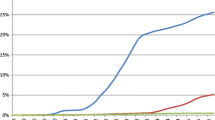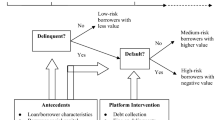Abstract
This paper analyzes the effects of counseling provided to borrowers in mortgage default (n = 299). Borrowers receiving more hours of counseling perceive counseling more favorably than those receiving fewer hours of counseling. Using measures of marketing efforts to instrument counseling time confirms the positive effect of counseling duration on borrower ratings of counseling. Borrowers are more likely to attend additional counseling sessions after receiving face-to-face counseling as opposed to telephone counseling, although preference among modes can largely be explained by time in counseling. Each additional hour of counseling reduces the marginal probability of a borrower moving to a more severe stage of foreclosure. Counseling could be more successful if provided for longer durations regardless of the delivery mode.

Similar content being viewed by others
Notes
Average inter item covariance: .667; Scale reliability coefficient: .8723 (Cronbach's alpha)
Average inter item covariance: .103 Scale reliability coefficient: .8333 (Cronbach's alpha).
Counseling time squared was also include in a variation of this specification to test for diminishing effects. The coefficient was not statistically significant.
Using a two stage least squares model, counseling time is effectively modeled, resulting in a first stage f-test of 4.2, P < .0014; sessions resulted in an f-test of 3.6 and P < .0008
References
Apgar, W.C., & Duda, M. (2004) Preserving homeownership: Community development implications of the new mortgage market. Retrieved January 14, 2007, from http://www.nw.org
Apgar, W.C., & Duda, M. (2005). Collateral damage: The municipal impact of today’s mortgage foreclosure boom. Minneapolis, MN: Homeownership Preservation Foundation. Retrieved January 14, 2007, from http://www.hpfonline.org
Collins, J. M., Belsky, E. S., & Case, C. E. (2005). Exploring the welfare effects of risk-based pricing in the subprime mortgage market. In N. Retsinas, & E. Belsky (Eds.), Building assets, building credit: Creating wealth in low-income communities (pp. 132–151). Washington, DC: The Brookings Institution Press.
Cordell, L. (2001). Innovative servicing technology: Smart enough to sustain homeownership gains? Panel presentation at the Research Institute for Housing America: 2001 Conference on Housing Opportunity: Will Technology Expand Housing Opportunity? Washington, DC.
Cutts, A. C., & Green, R. K. (2005). Innovative servicing technology: Smart enough to keep people in their houses? In N. Retsinas, & E. Belsky (Eds.), Building assets, building credit: Creating wealth in low-income communities (pp. 348–377). Washington, DC: The Brookings Institution Press.
Gramlich, E. M. (2004). Subprime mortgage lending: Benefits, costs, and challenges. Remarks at the Financial Services Roundtable Annual Housing Policy Meeting. Chicago, IL.
Hairston, J. (2006) Home foreclosures soar; Lender-friendly Georgia has highest rate in nation, The Atlanta Journal-Constitution, p. 1G.
Hartarska, V., & Gonzalez-Vega, C. (2005). Credit counseling and mortgage termination by low-income households. Journal of Real Estate Finance and Economics, 30(3), 227–243.
Hirad, A., & Zorn, P. M. (2002). Pre-purchase homeownership counseling: A little knowledge is a good thing. In N. Retsinas, & E. Belsky (Eds.), Low-income homeownership: Examining the unexamined goal (pp. 146–174). Washington, DC: The Brookings Institution Press.
Immergluck, D., & Smith, G. (2006). The impact of single-family mortgage foreclosures on neighborhood crime. Housing Studies, 21(6), 851–866.
Moreno, A. (1994). Assessment of post-purchase needs of low- and moderate-income homebuyers. (White Paper). Minneapolis, MN: Family Housing Fund.
Mortgage Bankers Association. (2005). National Delinquency Survey. Retrieved January 14, 2007, from http://www.mbaa.org
Perry, V. G., & Morris M. D. (2005). Who is in control? The role of self-perception, knowledge, and income in explaining consumer financial behavior. The Journal of Consumer Affairs, 39(2), 299–314.
Quercia, R., Cowan, S, & Moreno, A. (2004). The Cost-Effectiveness of Community-Based Foreclosure Prevention. Joint Center for Housing Studies of Harvard University Retrieved January 14, 2007, from www.jchs.harvard.edu
Quercia, R. G., McCarthy, G. W., & Stegman, M. A. (1995). Mortgage default among rural, low-income borrowers. Journal of Housing Research, 6(2), 349–369.
Quercia, R. G., & Wachter, S. M. (1996) Homeownership counseling performance: How can it be measured? Housing Policy Debate, 7(1), 175–187.
RealtyTrac. (2006). Irvine, CA. January 23, 2006 Retrieved January 23, 2006, from http://www.realtytrac.com
Roper Public Affairs and Media. (2005) Freddie Mac, Roper survey asks why more delinquent borrowers don’t call lenders for help. Retrieved January 12, 2007, from http://www.freddiemac.com
Salant, P., & Dillman, D. A. (1994). How to conduct your own survey. New York: John Wiley.
Staten, M. E., Elliehausen, E. C., & Lundquist, G. (2003). The impact of credit counseling on subsequent borrower credit usage and payment behavior. Washington, DC: Georgetown University.
Strauss, L., & Phillips, S. (1997). Housing counseling in rural America. Washington, DC: Housing Assistance Council. Retrieved January 12, 2007, from http://www.ruralhome.org
U.S. Department of Housing and Urban Development. (2005a) Housing Counseling Assistance: 2005 Summary Statement and Initiative. Retrieved January 12, 2007, from www.hud.gov
U.S. Department of Housing, Urban Development. (2005b) U.S. Housing Market Conditions. Washington, DC: HUDUSER.
Vandell, K. D. (1995). How ruthless is mortgage default? A review and synthesis of the evidence. Journal of Housing Research, 6(2), 245–264.
Acknowledgments
Sharon Tennyson for helpful advice and direction, Bruce Gottschall for support and expertise, and Charlie Corrigan for data assembly. Thanks also to the NHS Chicago, Homeownership Preservation Foundation and the City of Chicago for cooperation in sharing these data.
Author information
Authors and Affiliations
Corresponding author
Rights and permissions
About this article
Cite this article
Collins, J.M. Exploring the Design of Financial Counseling for Mortgage Borrowers in Default. J Fam Econ Iss 28, 207–226 (2007). https://doi.org/10.1007/s10834-007-9061-z
Published:
Issue Date:
DOI: https://doi.org/10.1007/s10834-007-9061-z




